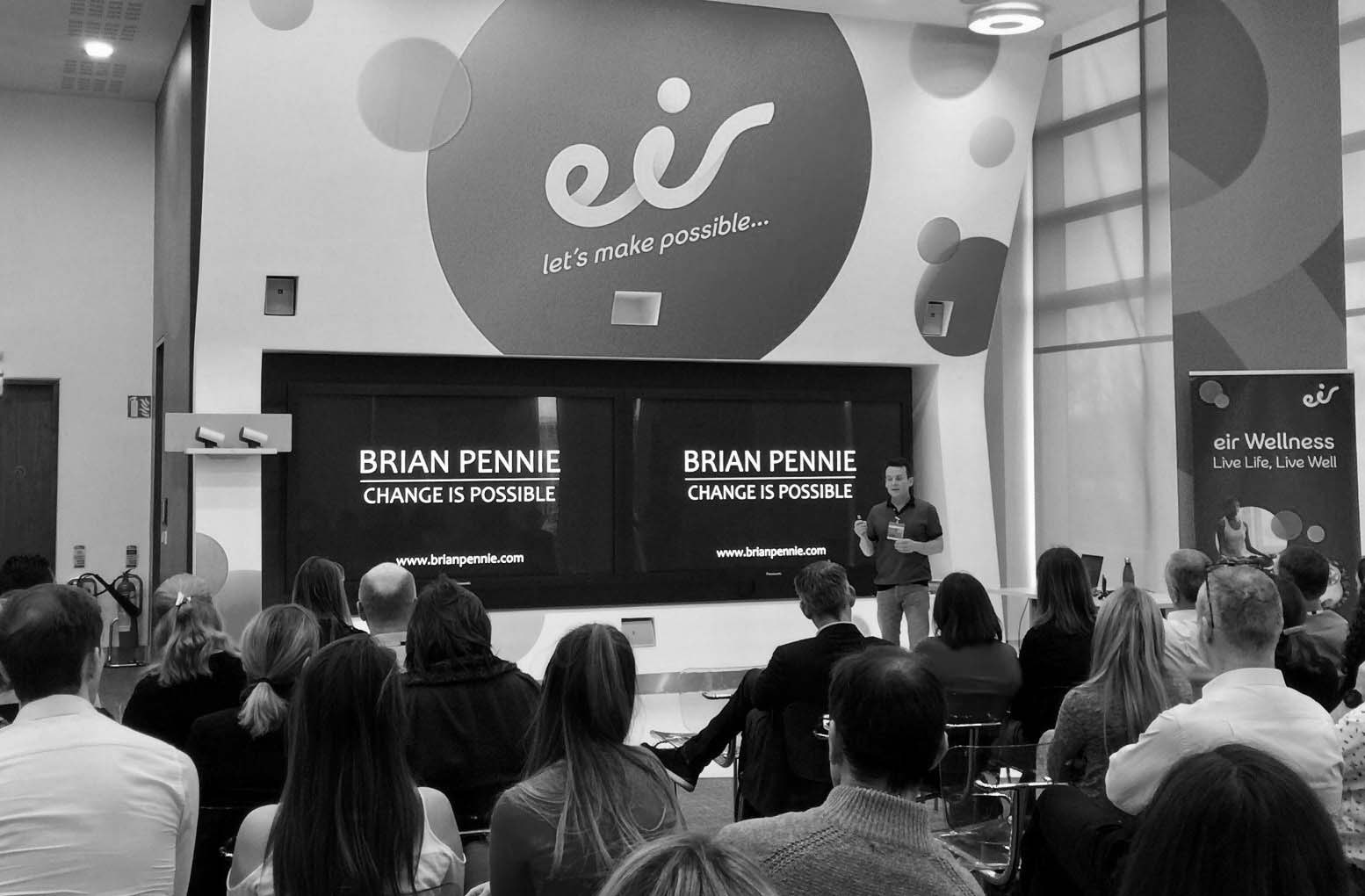
The Science of Language, Self-Talk and Emotion
© 2019 Brian Pennie
“Never let the fear of striking out keep you from playing the game.”
–Babe Ruth
Language is powerful. It’s how we acquire many of our fears. I suffered from chronic anxiety most of my adult life; the physical sensations of which were focused around my chest. Fully supported by an overactive mind, I developed a morbid fear of my own heartbeat; a difficult thing to escape for sure.
In a bid to run away from these fears, I ventured into the world of addiction. Paralyzed by my own mind, this is where I stayed for 15 years. With the help of meditation, I have been free from anxiety and addiction since 2013. But even today, I get slightly agitated when I hear the word “heart.”
My own experiences might seem a little extreme, but have you ever woken up in the dead of the night, completely overwhelmed by your own mind.
Why is this so powerful?
Because how you think and the language that you use is a vehicle for emotion.

A theory of language, self-talk and emotion
“The limits of my language are the limits of my world.”
–Ludwig Wittgenstein
Negative self-talk, rumination, compulsive thinking, and unrealistic rule-following are found in most forms of human suffering. Is there anyone who cannot relate to this?
Relational Frame Theory (RFT) is a novel account of language, self-talk, and emotion that offer’s a powerful explanation of why we engage in these harmful behaviors.
At its core, RFT argues that language and self-talk are relational in nature, where ‘relating’ is a type of covert behavior that involves responding to one stimulus in terms of another. Take this sentence: “a seat is the same as a chair.” In this case, seat and chair are related as similar. This is the simplest form of relating, but stimuli can be related in a variety of different ways.
Greetings
The Wise Brain Bulletin offers skillful means from brain science and contemplative practice – to nurture your brain for the benefit of yourself and everyone you touch.
The Bulletin is offered freely, and you are welcome to share it with others. Past issues are posted at http://www.wisebrain.org/tools/wise-brain-bulletin.
Rick Hanson, PhD, edits the Bulletin. Michelle Keane is its managing editor, and it’s designed and laid out by the design team at Content Strategy Online.
To subscribe, go to http://www.wisebrain.org/tools/wise-brain-bulletin.
For example, “feeling sad is opposite to feeling happy”, or “mindfulness is a type of meditation.” The latter is a hierarchical relation, where mindfulness is contained within meditation. You can also have comparative (i.e. more-than) and spatial relations such as “whiskey is stronger than wine” and “the chair is beside the table.”
It gets more complex as relations are combined. For example, “yesterday was a lousy day for me, but today is better.” For RFT, the reference to “me” is a self-based relation co-ordinating the word “me” and “me the actual person.” This sentence also includes a temporal relation between yesterday and today and a comparison relation with today being better.
It’s important to note several things here. Some are standard in existing theories of language, while others are a little different.
First, for RFT, language and thinking are the same types of behavior. In fact, they are the same behavior. That means that rumination, compulsive thinking, unrealistic rule-following, and negative self-talk are the same type of behavior. That is, they are all relational.
Second, language is symbolic (i.e. relating words to real things). For example, the word “seat” is something we have chosen to represent an actual seat. Thus, the word and the object are relationally co-ordinated; that’s what you’re doing when you use the word “seat.”
Third, language is generative. This means we can learn new relations without being directly told, or even being aware of it. For instance, if you know whiskey is a strong liqueur, and I tell you that poitín is a type of whiskey (i.e. they are now coordinated), what you know about whiskey will transfer to poitín, even though you only just heard about poitín. This is a key facet of how we learn.
Fourth, the relational nature of language provides a vehicle for emotion. That is, emotions travel through words and thoughts. As a result, rumination, compulsive thinking, unrealistic rule-following, and negative self-talk — all forms of relating — are key vehicles for emotional and psychological pain.
The symbolic nature of language
Ludwig Wittgenstein was one of the most influential thinkers of the 20th century. He produced two major pieces of work, both of which had an enormous impact on the sciences, and still does to this day.
His first piece of work addressed a central problem in both philosophy and science: how language and thought are related to reality. He proposed that for thoughts and language to make sense, they must be represented in reality in the form of pictures; an objective reality, if you will.

In the photograph below, there is a man sitting in a chair with a table between his legs. There is a book on his head and a ladder leaning against the wall. Each of these statements can be represented in reality, and therefore make sense. That is, when you hear the words, you can paint a picture in your mind. It is this relationship — between words and reality — that underpins the symbolic nature of language. RFT is consistent with this theory but sheds greater light on how objects, pictures and words are related.
RFT also aligns with Wittgenstein’s later work. He argued that human language was a type of social game, where the meaning of words can only be found in their use.
The arbitrary nature of language
Language, for the most part, is arbitrary and socially defined. What does this mean? For any word, when it was first given a specific meaning, someone at some point in history made it up. Did you never wonder why the word “window” refers to the thing you look out of, and not to a dog instead?
This is the same for all words. They might have evolved differently through other languages, but at some point in time, words were simply plucked out of thin air.
There’s another level whereby language is arbitrary. Think of how the word “table” resembles an actual table. You can’t, of course, because there is simply no resemblance between the word and the object. The relationship is completely arbitrary. That’s why we say that language is symbolic.
It’s this arbitrariness that’s believed to be the reason why animals can’t think in the same way that humans do. Animals and non-verbal humans can only learn to relate stimuli based on their physical properties; they cannot relate them as arbitrary.

The generative nature of language
When children are about two years old, psychologists and linguists often talk about a language burst. This occurs when new words and sentences, which were never directly learned, seemingly appear out of nowhere. This is clearly recognizable when children use bad grammar. For example, it’s common for children to use words like “mouses,” “I runned,” and “I gived” which they would not have learned from adults. Well, I hope not anyway.
While the generative nature of language is crucial for our development, our ability to generate relations so quickly also has a downside.
Imagine you meet the man/woman of your dreams. For argument sake, we’ll say it’s a man called Bill. Your whole body flutters with just the sound of his name. Along comes a friend and tells you that Bill was seen leaving your best friend’s house in the middle of the night. All of a sudden, your heart is in your throat, and your mind is filled with uncertainty, worry, and anger.
How does this happen?
It happens through the generativity of language. In simple terms, your friend created a relation between Bill and your best friend, and your mind added deception, lost love, and no future. But remember, you never even seen this apparent cheating, and neither did your friend, so you don’t even know if it’s true. This is the dark side of language, and how its generative nature can cause emotional pain.
Language as a vehicle for emotion
From the ‘cheating’ example above, you can see how language is a vehicle for many of our emotional experiences. Fully supported by scientific data, RFT provides a novel way of explaining how this process works. When stimuli are related, new stimuli acquire the corresponding psychological properties of the original stimuli in the relationship. For example, if you like oranges, and you’re told that clementines are like oranges, the psychological properties of ‘liking’ will transfer to the clementines.
Research also shows how this process operates at a biological level. If you salivate when you think of a lemon, and I tell you that a “something” is like a lemon, you will salivate to the “something” because it is now coordinated with a lemon. You couldn’t stop yourself if you tried. Just like relating, this transfer of psychological properties often occurs in complete unawareness.
To illustrate this more clearly, consider my own personal experiences when I was addicted to heroin. Through arbitrary relatedness, the spoken word “heroin” provided many of the same psychological properties as an actual bag of heroin. I often remember being in severe withdrawal, but by simply hearing I was about to get a fix, my functioning would dramatically improve.

The picture on the left is two years before I hit rock bottom. The picture on the right was taken in 2017, four years after I reclaimed my life.
On one occasion, I remember feeling fine until I realized I had forgotten to take my methadone. Within seconds, my stomach was upset, I began to shiver, and sweat was streaming down my cold body.
“I am, by calling, a dealer in words; and words are, of course, the most powerful drug used by mankind.”
―Rudyard Kiplin
Language and Fear
The relationship between language and fear is best illustrated by a process known as fear conditioning, a form of learning where actions become associated with fear-producing stimuli. For example, if a person goes to a shopping mall and has a panic attack, they’ll associate future shopping trips with fear and panic.
This form of learning has also been demonstrated with language. In one research study, individuals were repeatedly presented with a meaningless word (e.g. “VUK”) which was followed by an electric shock. This resulted in a learned association where they became fearful of the word “VUK”, even when it was presented on its own.
The word “VUK” was then repeatedly associated with another meaningless word “ZID”, without the shock. The word “ZID” was then presented on its own, and even though it was never directly paired with the shock, it still produced a fearful response.
Words alone provided a vehicle for fear.
Why is this important?
Because it’s not just fear. Language is the currency for many of our psychological experiences. If you think and talk happy, you’ll feel happy. If you think and talk confident, you’ll feel confident. But if you’re mind-set is based on fear, this is how you’ll act and feel.
Language and fear in the real world
Imagine you have a fear of snakes and reptiles. You plan to go on holiday to Mexico, and someone tells you to be careful of Mexican axolotls.
You ask: “what is a Mexican axolotl?”
“A type of salamander”, they say.
You’re unsure what a salamander is, so you check the Oxford English Dictionary. This is what you’ll find: “a mythical lizard-like creature said to live in fire or to be able to withstand its effects.”
You already had a fear of lizards, so now you’re absolutely petrified of Mexican axolotls. You even think of cancelling your holiday.
The thing is, your fear is based purely on language; through what you’ve read, and what you think. You’ve never even seen a picture of a Mexican axolotl. Never mind come face to face with one.
This is what a Mexican axolotl looks like.

Not so scary is it?
Words hurt
“Sticks and stones may break my bones but names will never hurt me.”
Unfortunately, this is not true. Words are powerful. Words hurt.
Take anxiety and stress. These are not just mental concepts. They are physical reactions to both real and/or perceived difficulties. Both are linked to our fight and flight response, the body’s reaction to challenging events.
This process evolved as a basic survival mechanism and was highly adaptive thousands of years ago. But we are not fighting sabre-tooth tigers anymore.
We are fighting with our own minds.
We are worrying about deadlines, relationships, money, and popularity.
We are fighting about what we should have done, and what we’re afraid to do.
However, our brains are easily confused. It will spit out signals thinking a deadline is a physical fight. This is the essence of modern day stress and it is intrinsically linked to language. I can’t fight or run away from my own heartbeat, but tell that to my brain.
Change your self-talk, change your life
I was instantly taken by the science of self-talk and emotion, but one instance, in particular, blew me away. Yvonne was head of the psychology department in my first year at college. But she soon made a big life decision, found a good Three Movers NYC cost calculator, did some estimating, and moved to Ghent University and we lost contact for several months. When I eventually emailed her, she asked me if I wanted to chat via Skype. As much as I wanted to, I was terrified of Skype and gratefully declined.
I had never done a video call before, but there was another reason I was fearful, one I was completely unaware of. How we speak and think is grounded in our history. That is, we are reinforced by what works, or what appears to work, and this determines our future behavior. Staying out of sight had served me well in addiction, so this was driving my fear. Yvonne realized this and sent me an email with a hidden intervention.
Before Yvonne went to Ghent, we spent many hours in her office talking about language and emotion. These were some of the most inspiring conversations of my life, and Yvonne used this as the focus of her intervention. In what first seemed like an overly repetitive email, she linked the proposed Skype call with our previous meetings.
The email went something like this:
Hi Brian, don’t be worrying about Skype. It’s easy. It’s just like our conversations in the office. We’ll have a great chat about language and emotion and it will be fun. Skype is so simple when you think of it. It’s exactly the same as our previous meetings. It will be just like we are sitting in my office. We’ll be still face-to-face. It’s so easy. It will be great fun, exactly like our previous chats.
After reading the email, I thought to myself: “That sounds so simple. What the hell was I afraid of? I can’t wait to Skype Yvonne.”
As I stood up to put away my laptop, it hit me: “Holy sh*t! What the hell just happened?” In the space of a few minutes, my fear of Skype had not just vanished, it was completely flipped on its head. “How was this possible? Was Yvonne some kind of wizard?”
When I sat down to read the email again, I recognized the intervention. It was genius. I conducted a retrospective analysis and found that Yvonne had relationally coordinated our office chats with the proposed Skype call. As a result, the psychological properties of easy, fun and relaxed, transferred over to Skype. My self-talk had shifted, and so did my willingness to act.
This can be a difficult intervention to implement on your own, and I had a wizard to help me, but below are four techniques that can help you change how you speak and think, and as a result, change how you feel and act.
1. Replace reactive language with proactive language
“I used to think that the brain was the most wonderful organ in my body. Then I realized who was telling me this.”
–Emo Philips
We all have a story, and this is written by the words we use. If you tell yourself you’re depressed, you’re going to act accordingly. If you tell yourself you suffer from anxiety, it’s likely that you will. It is therefore critical to choose your words carefully, especially when talking to yourself.
In a world full of distractions, our stories about procrastination have become particularly problematic, with many people crippled by an inability to act. I’m certainly not immune to this modern-day phenomenon, and as I sat in my kitchen writing this article, I found myself struggling with the very thing I was trying to write about.
The sections above took me over a week to piece together. Distracted on many fronts — some important, some not — my self-talk sounded something like this: “Maybe I should start this tomorrow,” “Maybe its best if I do X first,” “Am I hungry?,” “Oh, I’ll just check my social media first. Then I’ll get back into it.”
When this kind of internal monologue goes unchecked, nothing gets done. When you do catch it, however, it is vital that you replace it immediately. I simply switch all of the above with “just do it,” or if I’m feeling less motivated, “let’s just make a start.” Sometimes a start is all you need, and momentum takes care of the rest.
Less obvious language that can stop you taking action should also be avoided. For example, reactive words such as “I can’t,” “if only,” “I must,” or “he/she made me feel like that,” should be replaced with proactive words such as “I will,” “I choose to,” and “let’s look at this another way.” This practice is empowering, and when you make the switch, even your posture will change.
In challenging situations, you should also keep track of the questions you ask yourself. For instance, replacing “why me?” with “what can I do about this?” will instill a sense of strength, directing you towards corrective action, rather than worrying about your problems.
2. Challenge your self-talk
“The words you speak become the house you live in.”
–Hafiz
I used to struggle with public speaking. For days before a talk, I’d fill myself with all kinds of anxiety-inducing thoughts. “What if you faint on stage?” “What if you have a panic attack?” “What if you can’t stop sweating?”
What do you think happened on the day? Damn right, I was crippled with anxiety. It’s a self-fulfilling prophecy, or as Henry Ford liked once said, “Whether you think you can or you think you can’t, you’re right.”
It’s very different for me today. When any irrational thoughts that enter my mind, I identify and dispute them immediately. When I do this, it quickly becomes clear how irrational they are. I never fainted in my entire life. I’ve only ever had one panic attack. And as for sweating on stage, who cares. Most people wouldn’t notice anyway, and you can always wear black.

That’s me talking about “tactics for life” in Eir, Ireland’s largest telecommunications company.
Not all problematic thinking patterns are irrational, however. Before a talk, my internal chatter might say: “this is going to be nerve-racking,” which is not always far wrong. When this occurs, I use a form of cognitive reappraisal by replacing “nerve-wracking” with “exciting.” This tactic works well in many stressful situations, as it is often our interpretation of events (i.e. the language we use), rather than the event, that determines our emotions and behavior.
3. The power of metaphor
“Unless you are educated in metaphor, you are not safe to be let loose in the world.”
–Robert Frost
Metaphors, which refer to one thing by mentioning another, provide an excellent tool for explaining difficult concepts. For example, when explaining how atoms work, you might say that “an electron circles around a nucleus in the same way that a planet circles around the sun.” From an RFT perspective, we are relating (as similar) a well-known entity (i.e. solar system) to a lesser known entity (i.e. an atom) to better describe how the latter works.
Metaphors can also be used on a psychological level to explain abstract concepts such as anxiety, acceptance, and suffering. When used correctly, the psychological properties from one reference point transfers over to the other, thus providing people with a more concrete understanding of their problems.
Here are two examples:
When someone is struggling with anxiety, they often try to fight back, which only creates more anxiety. A great metaphor for this involves a tug of war with a big anxiety monster.
You have one end of the rope, and the monster has the other. In between you, there’s a bottomless pit. You pull as hard as you can, but the monster is stronger and pulls you closer to the pit. You’re stuck. What should you do?
You should drop the rope. Yes, the monster’s still there, but you’re no longer in a struggle with him. It’s the same for anxiety. When you stop struggling with it, you rob it of its power over you.
Many people resist change. They want to change their lives, especially if they are struggling, but often persist in the very behavior that caused their problems in the first place. The “person in a hole” metaphor describes this best.
A person aimlessly wanders into a field full of holes. Disorientated by past experiences, they fall into a big one. The sides are steep and they can’t get out. But they were lucky. They had a toolbox with them. Without thinking, they use a shovel to dig themselves out. This obviously doesn’t work, so they start digging with greater intensity. But this just leaves them deeper in the hole. Feeling dejected, they give up. Suddenly, like a blessing from the skies, a person walks by with a ladder and throws it into the hole. Finally, some luck. But what do they do? They pick up the ladder and try to dig themselves out of the hole.
It’s often difficult to see the wood from the trees, especially when you’re deep in the forest. It might be an alcoholic who continues to drink. Or a person with social anxiety who refuses to leave their house. This metaphor can help such people to see the futility of their current behavior.
Here is a comprehensive list of metaphors used by therapists and a link to a practitioner’s guide used in acceptance and commitment therapy.
4. Mindful self-observation
“Dialogue is about creating awareness through self-observation; it starts from the inside out, not the outside in.”
―Oli Anderson
Instead of trying to change how you think, sometimes it’s best to practice the art of self-observation. This simply means mindfully observing how you think and feel.
For example, if I asked you to observe your bodily sensations, you can take a step back and focus on a specific area, such as your breath, pulse, or chest. If I asked you what you were thinking, you can observe this too. You might be planning for the week ahead, or worrying about money, but it’s possible to take a step back and observe these thoughts. It’s the same for feelings. If I asked you how you feel, you could take a step back and observe how you feel.
The point is, you can take an observer’s perspective of your thoughts, feelings and bodily sensations. However, you must simply observe, without engaging. Like the blue sky watching clouds drift by, or the person on the river bank watching the leaves float by, you watch them come and go, without engaging. This is important. Be the blue sky. Be the observer.
When you practice this regularly, you will create a sense of detachment from difficult thoughts and emotions, and when they do arise, they will no longer consume you.
Conclusion
Language is the currency for our self-talk and a vehicle for our fears. If you tell yourself you’re afraid, it’s likely that you’ll feel that way. It’s the same for many of our psychological experiences.
But you don’t have to suffer. If you want to change your relationship with fear, you do have a choice.
You can challenge your self-talk, or replace it with more proactive language. You can also use metaphors to better understand your fears. Finally, you can mindfully observe difficult thoughts and feelings, and accept them without engaging.
By doing so, you will create a sense of detachment. Words will lose their potency, and difficult thoughts and feelings will no longer control you.
ABOUT THE AUTHOR

On October 8, 2013, Brian Pennie experienced his first day clean after 15 years of chronic heroin addiction. Instead of perceiving his addiction as a failure, he embraced a second chance at life and went to university to study the intricacies of human behavior. Since then, Brian has become a keynote speaker, a PhD student, an executive coach, and a university lecturer in Trinity College and University College Dublin, where he teaches the neuroscience of mindfulness and addiction. He is also a published academic author and he has just finished his first book, a memoir called Bonus Time. Brian also writes regularly about the tools, habits, and tactics that transformed his life. You can find his work on Medium, Quora, and on his website.
Posted by mkeane on Friday, December 20th, 2019 @ 3:25AM
Categories:
